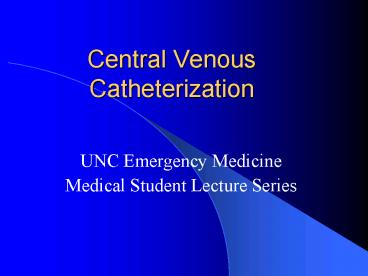Central Venous Catheterization - PowerPoint PPT Presentation
1 / 24
Title:
Central Venous Catheterization
Description:
Central Venous Catheterization UNC Emergency Medicine Medical Student Lecture Series Objectives Indications and Contraindications Complications Technique Basic ... – PowerPoint PPT presentation
Number of Views:1400
Avg rating:3.0/5.0
Title: Central Venous Catheterization
1
Central Venous Catheterization
- UNC Emergency Medicine
- Medical Student Lecture Series
2
Objectives
- Indications and Contraindications
- Complications
- Technique
- Basic principles
- Specifics by Site
- Tips
- Basic materials
3
Indications
- Central venous pressure monitoring
- Volume resuscitation
- Cardiac arrest
- Lack of peripheral access
- Infusion of hyperalimentation
- Infusion of concentrated solutions
- Placement of transvenous pacemaker
- Cardiac catheterization, pulmonary angiography
- Hemodialysis
4
Relative Contraindications
- Bleeding disorders
- Anticoagulation or thrombolytic therapy
- Combative patients
- Distorted local anatomy
- Cellulitis, burns, severe dermatitis at site
- Vasculitis
5
Complications
- Vascular
- Air embolus
- Arterial puncture
- Arteriovenous fistula
- Hematoma
- Blood clot
- Infectious
- Sepsis, cellulitis, osteomyelitis, septic
arthritis - Miscellaneous
- Dysrhythmias
- Catheter knotting or malposition
- Nerve injury
- Pneumothorax, hemothorax, hydrothorax,
hemomediastinum - Bowel or bladder perforation
6
Technique
- Seldinger technique
- Use introducing needle to locate vein
- Wire is threaded through the needle
- Needle is removed
- Skin and vessel are dilated
- Catheter is placed over the wire
- Wire is removed
- Catheter is secured in place
7
(No Transcript)
8
Basic Principles
- Decide if the line is really necessary
- Know your anatomy
- Be familiar with your equipment
- Obtain optimal patient positioning and
cooperation - Take your time
- Use sterile technique
- Always have a hand on your wire
- Ask for help
- Always aspirate as you advance as you withdraw
the needle slowly - Always withdraw the needle to the level of the
skin before redirecting the angle - Obtain chest x-ray post line placement and review
it
9
Location Advantage Disadvantage
Internal Jugular Bleeding can be recognized and controlled Malposition is rare Less risk of pneumothorax Risk of carotid artery puncture PTX possible
Femoral Easy to find vein No risk of pneumothorax Preferred site for emergencies and CPR Fewer bad complications Highest risk of infection Risk of DVT Not good for ambulatory patients
Subclavian Most comfortable for conscious patients Highest risk of PTX, should not do on intubated pts Should not be done if lt 2 years Vein is non-compressible
10
Subclavian Approach
- Positioning
- Right side preferred
- Supine position, head neutral, arm abducted
- Trendelenburg (10-15 degrees)
- Shoulders neutral with mild retraction
- Right side preferred
- Needle placement
- Junction of middle and medial thirds of clavicle
- At the small tubercle in the medial deltopectoral
groove - Needle should be parallel to skin
- Aim towards the supraclavicular notch and just
under the clavicle
11
(No Transcript)
12
Internal Jugular Approach
- Positioning
- Right side preferred
- Trendelenburg position
- Head turned slightly away from side of
venipuncture - Needle placement Central approach
- Locate the triangle formed by the clavicle and
the sternal and clavicular heads of the SCM
muscle - Gently place three fingers of left hand on
carotid artery - Place needle at 30 to 40 degrees to the skin,
lateral to the carotid artery - Aim toward the ipsilateral nipple under the
medial border of the lateral head of the SCM
muscle - Vein should be 1-1.5 cm deep, avoid deep probing
in the neck
13
(No Transcript)
14
Internal Jugular Central Approach
15
Femoral Approach
- Positioning
- Supine
- Needle placement
- Medial to femoral artery
- Needle held at 45 degree angle
- Skin insertion 2 cm below inguinal ligament
- Aim toward umbilicus
16
Femoral nerve
Femoral Vein
Femoral artery
NAVEL
17
Post-Catheter Placement
- Aspirate blood from each port
- Flush with saline or sterile water
- Secure catheter with sutures
- Cover with sterile dressing (tega-derm)
- Obtain chest x-ray for IJ and SC lines
- Write a procedure note
18
Procedure Note
- Name of procedure
- Indication for procedure
- Comment on consent, if applicable
- Describe what you did, including prep
- Comment on aspiration/flushing of ports
- How did patient tolerate procedure
- Any complications
19
Tips
- After 3-4 tries, let someone else try
- Get chest x-ray after unsuccessful attempt
- If attempt at one site fails, try new site on
same side to avoid bilateral complications - Halt positive pressure ventilation as the needle
penetrates the chest wall in subclavian approach - If you meet resistance while inserting the guide
wire, withdraw slightly and rotate the wire and
re-advance - Align the bevel with the syringe markings
- Use the vein on the same side as the pneumothorax
- Withdraw slowly, you will often hit the vein on
the way out
20
Ultrasound-Guided Central Venous Access
- Becoming standard of care
- Vein is compressible
- Vein is not always larger
- Vein is accessed under direct visualization
- Helpful in patients with difficult anatomy
21
Needle entering IJ
22
Compression of vein with US probe
Femoral Artery
Femoral Vein
23
Catheterization Kits
24
References
- Clinical Procedures in Emergency Medicine,
Roberts and Hedges, 4th edition, 2004 - Clinicians Pocket Reference, Leonard Gomella,
8th edition, 1997 - Atlas of Human Anatomy, Frank Netter, 2nd
edition, 1997































